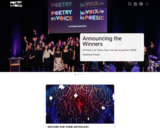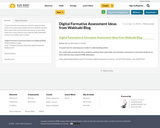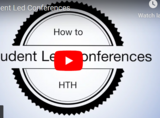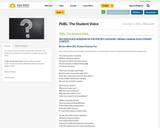
Some great ideas in here!
- Subject:
- Education
- Material Type:
- Teaching/Learning Strategy
- Author:
- PBS
- Date Added:
- 02/12/2019

Some great ideas in here!

Students explore call and response songs through singing.

"Poetry In Voice/Les voix de la poésie is a charitable organization that encourages Canadian students to fall in love with poetry through reading, recitation, and writing.
We provide an online anthology of classic and contemporary poems and comprehensive teaching materials on our website, all free of cost. We also run student recitation competitions, where we award over $75,000 in travel and prizes annually."

Use the "Slinky Test" to get students to start thinking about sentence length and variety.
This resource provides a video to explain the strategy and a number of supports to help you teach students when to use sentences of varied length to improve their writing.

17 great tools for assessing your student's understanding online!
You could easily provide this list to students and have them select their own formative assessment or have them build one to share with the class using the PeBL philosophy.
Author: by Lee Watanabe-Crockett

Students explore healthy posture through storytelling and observation.

"Have you been thinking SLCs sounded like a good idea but you were afraid of screwing them up? OR have you been doing them for years but never really felt like you were doing them “right”? This article by veteran teacher Kelly Williams has you covered."
How to : plan and prepare, schedule, decide a structure, decide roles and what to share. This resource includes a sample parent letter.

The following document suggests ways that students can "write more" or add more to their writing in a meaningful way by adding: descriptionproof/evidencevocabularlyvoice(s)explanationInportance/Persausion

This website provides short support videos by grade level for:
*readers have different voices
*readers make inferences
*readers retell/summarize
*readers question and predict
*readers track details
*readers juggle multiple texts
*SEL

Ditch That Textbook offer 4 videos to will support teachers in preparing students for a future in which they will be in control, by letting them practice having autonomy and choice.
VIDEO 1: EMPOWER STUDENTS WITH CLASSROOM VOTING
VIDEO 2: BUILD RELATIONSHIPS WITH CLASSROOM SURVEYS
VIDEO 3: INSTILL RESPONSIBILITY WITH CLASSROOM JOBS
VIDEO 4: CREATE AN "OUR CLASS, OUR VOICE" CLASSROOM" - AUTONOMY & VOICE

The student voice as to why we need PebL.
This poem was entered into the Mensa Canada Poetry contest and won 2nd place.

"Pear Deck was founded by educators on a mission to help teachers engage every student, every day. With solutions rooted in active learning and formative assessment, we make it easy for you to connect with learners of every age and ability. When that happens, more students participate and learn, classroom community improves, and you'll know you're making a difference."
Watch the video to see how Pear Deck works!
The Free Version includes the ability to:
Design brilliant lessons with interactive questions, polls, quizzes, formative assessments
Work seamlessly with powerful classroom tools from Google and Microsoft
Ready-to-teach templates designed by educators
Support flexible work with Student Paced mode
Teach vocabulary with Flashcard Factory*

Students explore whispering, speaking, singing, and calling voices.

Students continue to build a rigorous background in human sensors and their engineering equivalents by learning about electronic touch, light, sound and ultrasonic sensors that measure physical quantities somewhat like eyes, ears and skin. Specifically, they learn about microphones as one example of sound sensors, how sounds differ (intensity, pitch) and the components of sound waves (wavelength, period, frequency, amplitude). Using microphones connected to computers running (free) Audacity® software, student teams experiment with machine-generated sounds and their own voices and observe the resulting sound waves on the screen, helping them to understand that sounds are waves. Students take pre/post quizzes, complete a worksheet and watch two short online videos about "seeing" sound.

A recent blog by Grant Wiggins affirmed what I have long believed about creativity: it is a 21st-century skill we can teach and assess. Creativity fosters deeper learning, builds confidence and creates a student ready for college and career.
However, many teachers don't know how to implement the teaching and assessment of creativity in their classrooms. While we may have the tools to teach and assess content, creativity is another matter, especially if we want to be intentional about teaching it as a 21st-century skill. In a PBL project, some teachers focus on just one skill, while others focus on many. Here are some strategies educators can use tomorrow to get started teaching and assessing creativity -- just one more highly necessary skill in that 21st-century toolkit.